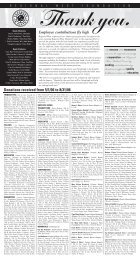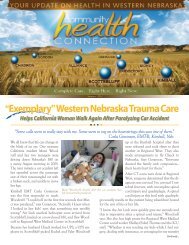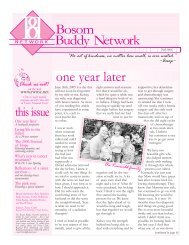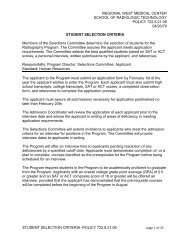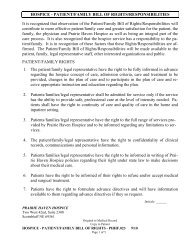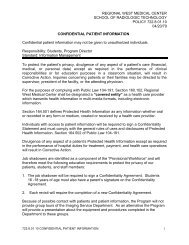2010 Annual Report - Regional West Medical Center
2010 Annual Report - Regional West Medical Center
2010 Annual Report - Regional West Medical Center
Create successful ePaper yourself
Turn your PDF publications into a flip-book with our unique Google optimized e-Paper software.
Reconstructive Surgeryafter Breast CancerBy Mary C. Snyder, MDPlastic and Reconstructive Surgery | Monument Plastic SurgeryBreast cancer continues to be the most commonly diagnosed malignancy in women in the U.S., after non-melanoma skincancer. Over the last 10 years, rates of breast cancer have decreased in women over the age of 50, yet the lifetime risk ofdeveloping a cancer of the breast remains one in eight. Over 200,000 cases of invasive disease are diagnosed each year andearly stage disease, or DCIS, is found in over 50,000 patients (1). Death rates from breast cancer have declined over the last20 years, and the current prognosis is favorable, with five year survival rates of approximately 80 percent both at <strong>Regional</strong><strong>West</strong> <strong>Medical</strong> <strong>Center</strong> and nationwide (2). There are approximately 2.5 million breast cancer survivors in the United States,with that number expected to rise over the next 10 years (3).Although many women elect for breast conserving treatment(such as lumpectomy) when faced with the diagnosisof breast cancer, approximately 30 percent of breast cancerpatients choose to undergo mastectomy (4). Recent datasuggests more women are undergoing prophylactic mastectomyon the uninvolved breast in cases of unilateral disease.Additionally, with the advent of genetic testing for BRCA, bilateralprophylactic mastectomies are being performed morefrequently (5). An increase in the number of mastectomiesperformed has led to an increased number of breast reconstructiveprocedures (6).Although not every patient is a candidate for breast reconstruction,it is an option for many women, either at the timeof mastectomy or after completion of treatment. The numberof women who undergo breast reconstruction followingmastectomy in the United States is just under 20 percent.Some studies have shown that women who undergo breastreconstruction after mastectomy report improved quality oflife, including psychosocial and sexual well being, as comparedto those who undergo mastectomy alone (7,8). Significant discrepanciesexist in rates of breast reconstruction among minoritiesand those in certain geographic areas. The Women’sHealth and Cancer Rights Act, which mandates insurancecoverage of breast reconstruction following mastectomy, wasenacted in 1999 (9). However, rates of reconstruction have notsignificantly increased after this law took effect, indicating factorsother than insurance coverage are involved, including lackof availability of a reconstructive surgeon or failure to refer tosuch specialists (10).Breast reconstruction generally falls into one of two categories,autologous tissue or implant. Reconstruction with autologoustissue usually involves skin, fat, and muscle moved from theabdomen, back, buttocks, or thighs. The most common type ofautologous tissue used is the TRAM flap, which involves movingabdominal tissue to the chest to recreate the breast. This tissuerequires a blood supply, provided either by an abdominal musclewhich remains attached, or by a microvascular procedure tosupply blood from vessels in the chest. The TRAM flap is usedmost often in unilateral breast reconstruction and is associatedwith the highest satisfaction rates among patients regardingtheir reconstruction, likely a result of the ability of the tissue tomatch the natural shape and feel of the opposite breast (11).Implant-type reconstruction is a multi-stage procedure that involvesplacement of a temporary implant, or tissue expander, atthe first stage. The tissue expander allows the skin and muscleof the chest wall to be gradually stretched to a size and shapethat is acceptable to both the patient and the surgeon. Once theappropriate expansion is reached, the tissue expander is removedand either a silicone or saline implant is placed. This type of reconstructionhas a quicker recovery time than most autologoustissue reconstructions as it does not involve an additional surgicalsite on the body, such as the abdomen. Many women who elect tohave prophylactic mastectomies chose to have expander-implantreconstruction as it is easier to match the two breasts with implants,resulting in high patient satisfaction rates (11).Continued...16



